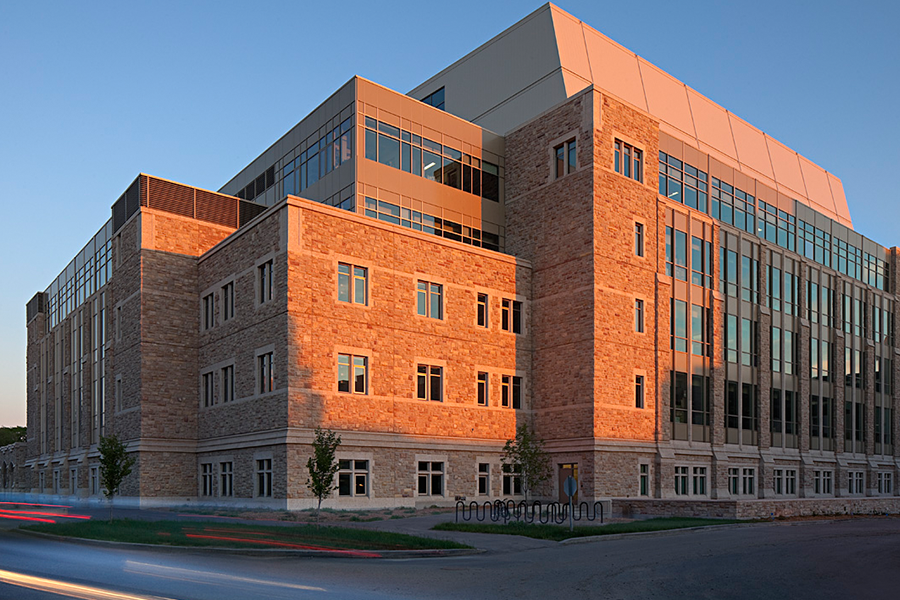Health Sciences governance structure change
A change in the governance structure of the Council of Health Science Deans (CHSD), the collective grouping of the health science deans and executive directors at the U of S, will transform how those units work together to teach and do research.
By Lesley Porter Established in 2009, the CHSD was tasked with finding education and research synergies across the disciplines and creating a vision for the Health Sciences Building, in the infancy of its construction at the time. And while that council structure had good goals and intentions, putting the plan to action proved harder than anticipated, said Lois Berry, who was recently appointed as interim assistant vice-provost of health as part of the reorganization.
Established in 2009, the CHSD was tasked with finding education and research synergies across the disciplines and creating a vision for the Health Sciences Building, in the infancy of its construction at the time. And while that council structure had good goals and intentions, putting the plan to action proved harder than anticipated, said Lois Berry, who was recently appointed as interim assistant vice-provost of health as part of the reorganization.
"We had an agenda in place, but it didn't bring us to where we needed to be, just because the deans all have more than full-time jobs themselves," she said.
A comprehensive report, carried out last spring by external consultant Ronald Bond, recommended a number of changes to the council's structure, including the establishment of a chair with vice-provostial status. Earlier this year, Interim Provost Ernie Barber appointed Dr. Preston Smith, dean of the College of Medicine, as the vice-provost of health. Soon after, Berry, former interim dean of the College of Nursing, was seconded to the portfolio as well. While Smith is responsible for fostering relationships with external partners (such as health regions and government), Berry will work with internal groups to promote the health sciences ethos.
This includes two major mandates, explained Berry. The first is to increase the amount of interdisciplinary health science research on campus and "bring together working teams to increase research outputs." For this, the CHSD enlisted Lisa Kalynchuk, a neurology professor in the College of Medicine and mental health researcher. Kalynchuk, as lead of the neuroscience research cluster—a group uniting faculty, post-docs and students from many colleges and units on campus to collaborate on research—is "well-placed to tackle this issue," said Berry.
The second priority is to co-ordinate interprofessional education opportunities in the health sciences. Similarly, someone will be charged with leading this initiative. "They'll work with deans and associate deans to develop a common curriculum for courses or seminars so we can bring our students together," said Berry, whose secondment runs until August 2016.
Berry added that within both mandates is the overriding theme of Aboriginal health issues. "It's important to have that conversation with the colleges about how we can best integrate Aboriginal health concepts in our curriculum," she said. "There seem to be a lot of ongoing Aboriginal health initiatives without much cohesion or an underlying strategy."
Additionally, she explained, working together will help highlight if there is a process or concept that works well for one college that can be applied in another college.
Going forward, Berry hopes to work with institutional planning to identify the key metrics that are signs of success. Until then, she looks to the neuroscience and cancer research clusters, as well as One Health—integrating human, animal and ecosystem health—as perfect examples of interdisciplinary research and education.
Interdisciplinary research: the Health Sciences Building accommodates several clusters of researchers and is designed to facilitate the interactions of these interdisciplinary research teams. The neuroscience team, for example, is comprised of researchers from the Colleges of Medicine, Pharmacy and Nutrition, and Arts and Science to study areas related to Alzheimer's, Parkinson's, depression, anxiety and other neurological conditions.
Interprofessional education (IPE): shared learning among students and professionals to gain the knowledge, skills and values required to work in a changing health landscape. A popular Health Sciences IPE initiative is Longitudinal Elderly Person Shadowing (LEPS), which pairs student groups with a senior resident at LutherCare Communities to familiarize students with the physical, social, emotional and spiritual aspects of aging.
Fast facts about the Health Sciences:
- Comprised of the Colleges of Dentistry, Kinesiology, Medicine (including the School of Physical Therapy), Nursing, Pharmacy and Nutrition, the Western College of Veterinary Medicine and the School of Public Health.
- D- and E-wing have achieved silver and gold Leadership in Energy and Environmental Design (LEED) certification status, respectively, for their sustainable design features.
- The arched porch of the D-wing main entrance is clad with reclaimed field stone from the old hospital laundry building.
- E-wing connects to Royal University Hospital and wraps around the Dental Clinic building.
- A tunnel, underneath Campus Drive, will connect Health Sciences to the Gordon Oakes Red Bear Centre once it opens.

